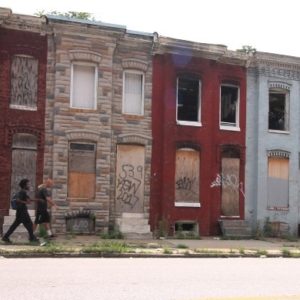
Antonio Coffield-Baltimore Revitalization: Economic Inclusion in Underserved Communities.
Is it enough to see pictures of neighborhood deterioration? Is it enough to hear about how a city neighborhood is perceived as no longer “safe”? While pictures may speak a thousand words, the pain felt by those living in the affected communities can never be truly pictured.
What can we do?
How we got here is not as important as how we can enact change, and reverse the trend of decay. Urban decay is yet another term used to define neighborhoods scarred from changes to local business, demographics, economics etc. This is a severe issue that is plaguing Baltimore, Maryland. Baltimore loses both money and people at an astounding rate, mainly due to the city itself falling into disrepair. In fact, the more people that they lose, the more likely it is that their buildings will never get fixed.
While there are many reasons that this may happen, such as the high poverty rate, the fact that 4 out of 5 black youth never graduate, or the high level of former inmates, we as a people have let this happen. As a result, it is on us as a society to help our fellow man, and help bring the community back from the brink.
Moreover, rebuilding the city requires a lot of financial and resource aid, as well as government responsibility and even help from the locals. Getting the locals involved is vital to making Baltimore a wonderful place to live, as it can boost the economy and provide jobs for the people who live in it. This can also be vital, as allowing the residents to have a voice in the revitalization of their communities helps to prevent gentrification, which can otherwise hurt the communities that are trying to be helped.
Maryland has committed to offering over 700 million dollars to this cause, and have even identified 17,000 vacant buildings that need to be demolished, landscaped, and rebuilt from the ground up. Other groups have even offered their time and resources in order to get the ball rolling. However, there is a lot that has to be addressed before we can fix the city as a whole.
The issues
For instance, the recent history of crime, which has harmed both the people and the surrounding businesses. Fixing this requires a lot of work, and includes increased educational opportunities, more employment opportunities for the residents, and an infrastructure designed to support new businesses in the area.
This can be helped through private investments. These will increase entrepreneurship, spurring small business growth and bringing new life to old but updated neighborhoods. Social Enterprise initiatives such as Humanim and Project Jumpstart will be vital in helping the community work together in order to revitalize the neighborhoods and create new economic growth. The insurgence of crucial business investment will be vital to establishing the economic alignment needed to invite positive change in many of our neighborhoods.
Helping the city will help to solve a lot of the issues, such as lowering the crime rate, boosting employment, and making the community a much better place for all that live there. It is our responsibility to do what we can to help I whatever way that we can.

